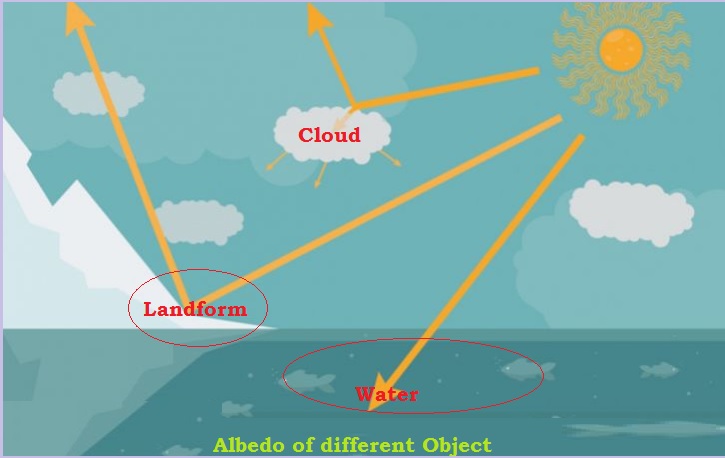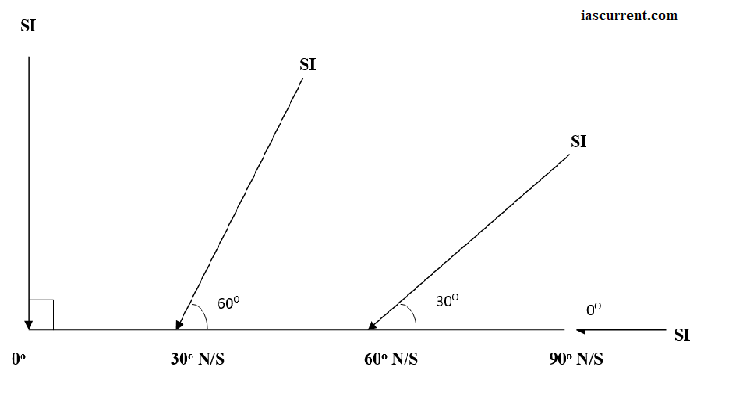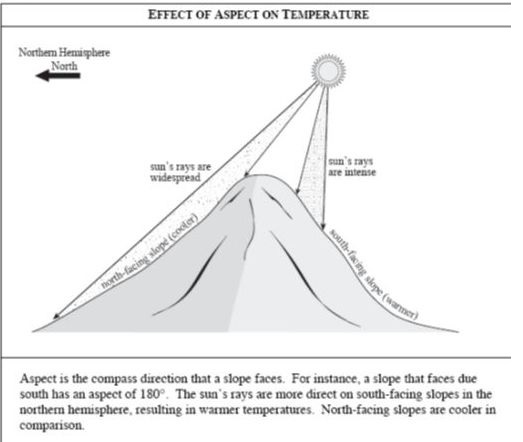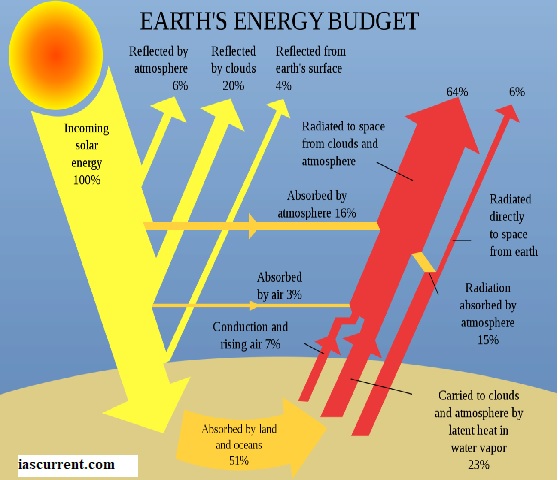As the earth is elliptical in shape, it does not get heated evenly. Heat distribution is uneven and unequal on the globe. The Sun heats the equatorial region gets more heat compared to the polar region. It is the balance between incoming short wave radiation and outgoing longwave terrestrial radiation in a given duration of time.
The Albedo of Earth

The reflectivity of heat coming from the earth’s surface is called the Albedo of Earth. Albedo depends on two factors:
- Solar Incidence: If solar insulation is vertical, Albedo is low since absorption is high. Consequently, if solar insulation is slanting, Albedo is high since absorption is low.
- Nature of Surface : SNOW > BARREN LAND > CROPLAND > FOREST > WATER
Global Distribution of Temperature
The global distribution of temperature is determined by the following factors :
- Latitude
- Altitude
- Distribution of land & water
- The elliptical orbit of the earth
- Winds
- Ocean currents
- Orientation of slopes
- Nature of land.
Latitude
Midday sun is twice overhead on equator 21st March & 23rd September) during equinoxes once over the Tropic of Cancer (21st June –summer solstice ) and once overhead the Tropic of Capricorn (22nd December – winter solstice) while the midday sun is overhead on the equator. Solar isolation is vertical on the equator and slanting towards poles. This slant increases with latitude. With vertical SI, solar energy concentrates on the surface which produces a high temperature. As slant increase, solar energy is in diffused which routs in relatively lower temperature. This temperature declines from low latitudes to high latitudes.
With vertical SI, solar energy concentrates on the surface which produces a high temperature. As slant increase, solar energy is in diffused which routs in relatively lower temperature. This temperature declines from low latitudes to high latitudes.
Thus vertical SI meets minimum slathering and slant SI meets high Scattering & diffusion which gives the relation:
Absorption of SI by surface α [1/ loss through scattering, 1/ reflectivity of surface]
In June (summer solstice), the sun is overhead the Tropic of Cancer. North receives minimum SI. It is summer in the North. Similarly, in December (winter solstice), the midday sun is overhead the Tropic of Capricorn. South receives maximum SI & it is winter in the North: July is the hottest month of North and January is the hottest month of South. Similarly, July is the coldest month in the South, and January coldest month in the North.
Note that the time lag between maximum SI and maximum monthly temperature in one month is due to the lag created for heating up of atmosphere temperature by terrestrial radiation.
Now since the midday sun is never overhead polewards of both tropics of Cancer and Capricorn, the annual temperature decline from low latitudes to the high latitude.
Because of the built of the earth, the summers and winter of the south are highly extreme whereas the north has mild summer and winter. Also in low latitudes, summers are extreme and long whereas in high latitudes winters are extremely cold and long.
Altitude
The atmosphere is heated by longwave thermal radiation (LWTR) which is released from the surface of the earth after being heated by incoming Short Wave Solar Insulation (SWSI) since 71% of Earth’s surface is water. Ocean and coastal regions have moderate temperatures, but as altitude increases, the LWTR decreases in intensity with an increase in altitude. In normal atmosphere conditions, this lapse rate is 6.5 degrees Celcius per kilometer. Thus on a given latitude, low-lands have higher temperatures compared to highlands.
Distribution of Land & Water
Since the specific heat of water is the greatest, its rate of heating and cooling is slow. In comparison, the specific heat of land is very less. This land masses get heated and cooled at a faster rate. Because of this high differential rate of heating and cooling, the diurnal & annual range of temperatures in continents is very high. This type of climate is called Continentality.
On the contrary, in coastal areas, islands have a low diurnal and annual range of temperature due to the moderating influence of oceans. This type of climate is called Insularity.
Elliptical Orbit of Earth
The SI received by the earth when it is at perihelion is 7% more compared to the SI received at aphelion. At perihelion, the North has winter season while the South has the summer season. At aphelion, the North has summers while the South has winters. Therefore, summers and winter are mild in the north while they are extreme in the South.
Winds
The flow and nature of winds control the temperature of a place. If a place is under the influence of cold winds, its temperature is relatively low whereas if the place is under the influence of hot winds, the temperature is relatively high.
Ocean Currents
Ocean currents play an important role in determining the weather conditions of coastal regions. If there are two coastal locations on given latitude, then the location under the influence of warm ocean currents shows warmer temperatures compared to a location under influence of cold ocean currents.
Since ocean circulation is clockwise in the North and anti-clockwise in the Southern Hemisphere, the east of continents are under the influence of warm ocean currents and are warmer compared to the west coast that is under the influence of cold currents.
The orientation of Slopes
It controls the distribution of temperature on mountains that have an east-west extension (e.g. Himalayas, Atlas mountains).
In the North, the southern slopes will get more sunshine whereas the northern slopes will be a shadow area. This explains why the Sothern slopes of the Himalayas are bush and green whereas the northern slopes are perpetually under snow and ice glacier.
Similarly, in the south, the northern slopes will get more sunshine while the southern slopes will be a shadow area.

This is why the northern slopes in the north & southern slopes in the South are colder compared to their opposite slope.
Nature of Land Surface
Surface covered with water, cropland, and bush have relatively low temperature as energy is lost from the surface through evaporation& transportation to the atmosphere.
Land surfaces covered with rocks, sand, etc- have high surface heating and high temperature. The diurnal and annual range of temperature is also low for surface covered with water bodies and plants. These are high for land covered with sand, rocks (or) even barren land.
Heat Budget of Earth
From the figure above, one sees that, of the 100 units of incoming short wave solar insulation, 16 units are absorbed by the atmosphere. Of the rest, 30 units are reflected off the clouds, particulate matter, icecaps & glaciers.
From the remaining 54 units, 17 units are received by the earth as diffuse daylight and the remaining 37 unit are received by the atmosphere in the form of long-wave terrestrial radiation which cannot leave the atmosphere and is responsible for atmosphere heating.




